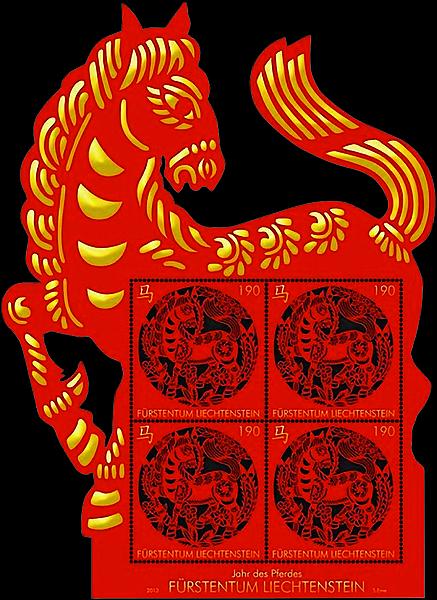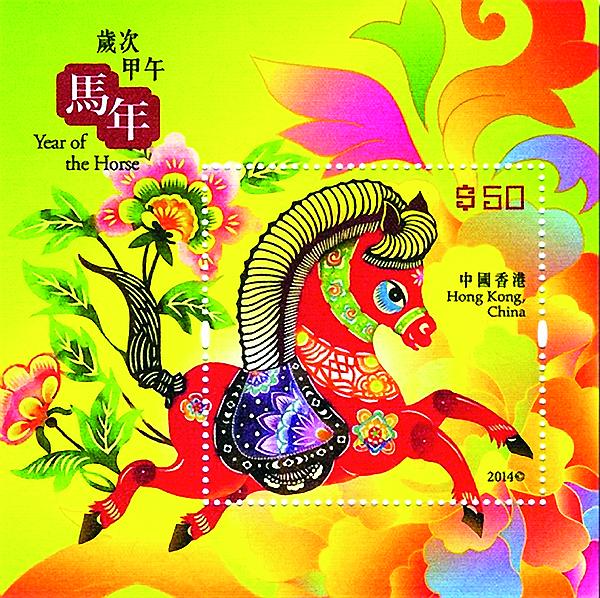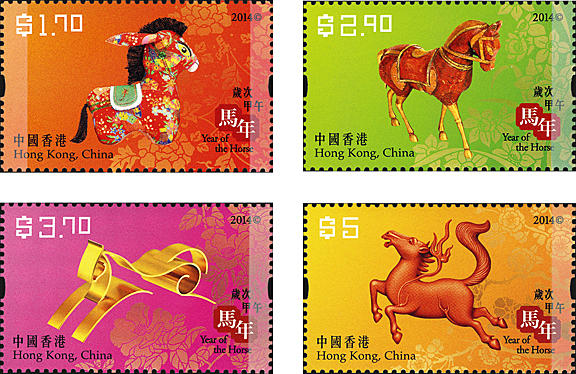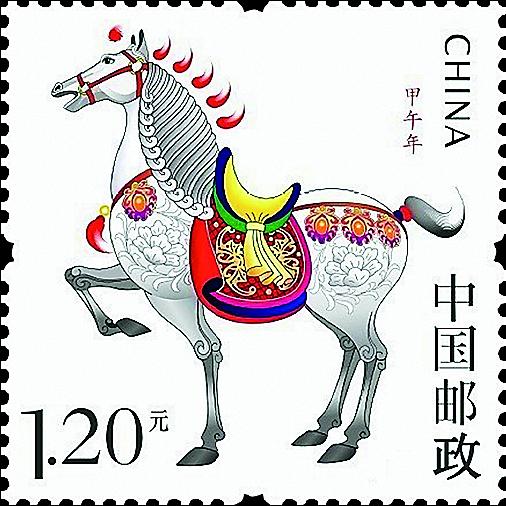World Stamps
Hong Kong tops Year of the Horse stamp popularity poll
Stamps from Hong Kong, Liechtenstein and New Zealand won a competition for the best Year of the Horse stamps.
The contest included 65 countries or special administrative regions that issued stamps in late 2013 or early 2014 celebrating the Year of the Horse. The Year of the Horse began Jan. 30, 2014, and will end Feb. 18, 2015.
The contest was organized by the Chinese Shengxiao (Zodiac) Philatelic Society and sponsored by the weekly newspaper Philately, Suzhou Shengxiao (Zodiac) Stamp Museum, and six philatelic units. Unlike previous competitions held from 2010 to 2013, the Year of the Horse stamp competition was only open to members of the philatelic society, not to other stamp collectors. China’s fastest growing philatelic society, it has more than 5,400 members.
The winning stamps were selected by these members and a jury of 25 experts.
The society members and experts were asked to select the three best Year of the Horse stamps, and 1,300 votes from China, Taiwan, Hong Kong, Macau, Australia and the United States were received.
China’s Year of the Horse stamp was not eligible because the contest focused on stamps from other countries and special administrative regions. The panel gave China’s 1.20-yuan stamp issued Jan. 5, 2014, an honorary award.
The shape of the white horse shown on the stamp is modeled after the tricolored porcelain horse of the Tang dynasty (618-907). The peony patterns on its body symbolize wealth and good luck, while the two bats drawn on the saddle represent instant blessings.
Printed with a special silver ink, the stamp sparkles with metallic luster that appears to change when viewed at different angles.
Shaohua Chen designed this stamp, as well as previous stamps in this multiyear series.
For the Year of the Horse design, he originally submitted a dark horse in military body armor. After this design was rejected, he changed the color of the horse to champagne and finally to the white horse.
Hong Kong’s Year of the Horse stamps received 660 votes to place first in this contest for the third year in a row. The Year of the Horse set issued Jan. 11, 2014, includes four stamps and three souvenir sheets.
The four stamps portray horses in different forms of traditional Chinese arts and crafts: fabric pony, $1.70; wood carvings, $2.90; metal sculptures, $3.70; and lacquer, $5.
Hong Kong Post also issued a souvenir sheet with a $10 stamp and a silk souvenir sheet with a $50 stamp to mark the joyous occasion.
According to the certificate of authenticity, this sheet was produced with 100 percent genuine silk made in Italy.
Another souvenir sheet from Hong Kong contains two $50 stamps, a Year of the Snake stamp in silver foil and a Year of the Horse stamp in 22-karat plated gold.
Hong Kong Post began issuing stamps featuring the animals of the Chinese zodiac in 1967. The 2014 Year of the Horse issue is the third set in the fourth series of Lunar New Year stamps. Each series continues for 12 years.
The Chinese Shengxiao Philatelic Society’s Nov. 5 press release about the competition complimented Hong Kong’s stamps for their prominent theme, colorful auspicious patterns, and the festive floral pattern in the selvage.
Liechtenstein issued its third Chinese zodiac stamp Nov. 11, 2013, to celebrate the Year of the Horse. Following the pattern of the previous two years, Liechtenstein used a laser paper-cutting technology to create a postage stamp in silhouette form. The typography was executed by hot stamping on gold foil.
An innovation is that the entire four-stamp sheet has been cut out in the shape of a horse.
With 498 votes, this self-adhesive stamp from Liechtenstein came in second place. Liechtenstein placed third in the 2012 contest (Year of the Dragon) and fourth in the 2013 contest (Year of the Snake).
The press release about the competition mentioned the horse shape of the sheet, the exquisite workmanship and the beauty of this novel design.
New Zealand issued four Year of the Horse stamps and a souvenir sheet Jan. 8, 2014. This set received 297 votes, and for the third consecutive year, New Zealand has placed third in the poll.
The New Zealand designs represent the strong, successful coexistence of the Chinese and New Zealand cultures. The images on the stamps are shown against a background of New Zealand as “the land of the long white cloud.”
The 70¢ stamp depicts a Chinese calligraphic horse. Many Chinese characters are derived from pictograms, stylized drawings of the objects they represent.
The $1.40 stamp shows a paper-cut horse.
It is a Chinese tradition to paste red paper-cuts on the doors of houses to bring good luck and happiness to the families who live there.
The $1.90 stamp features a line art illustration of the equestrian sport of show jumping, linking the image of the horse with the Chinese lunar year.
The $2.40 stamp pictures the Rotorua Museum of Art and History, red lanterns and fireworks.
The $1.90 and $2.40 stamps represent cultural links between China and New Zealand.
The souvenir sheet from New Zealand includes the four stamps se-tenant (side-by-side).
The press release about the competition said that the New Zealand’s Year of the Horse stamps reflect the combination of Chinese culture and local culture in a creative, fresh and festive manner.
This is the fifth year of the competition for the best Chinese zodiac stamps. Rounding out the Year of the Horse top 10 are Macau (fourth place, 129 votes), Canada (fifth, 126), Taiwan (sixth, 109), Malaysia (seventh, 77), France (eighth, 68), Curacao (ninth, 58) and Japan (10th, 57).
The United States Year of the Horse received 17 votes, coming in 33rd place, the midpoint for all 65 countries or special administrative regions included in this contest. The central design of the U.S. stamp features drums, not a horse.
The votes received for any one country or administrative region were lower than those in the 2013 (Year of the Snake) contest for two reasons.
First, the competition was only open to member of the Chinese Shengxiao Philatelic Society. It reduced the source of the voters.
Second, more countries issued Year of Horse stamps (65, compared to 46 in 2013), which led to the dispersion of votes.
Actually, 11 countries that issued Year of the Snake stamps did not issue Year of the Horse stamps. On the other hand, 30 countries that did not issue Year of the Snake stamps last year did issue Year of the Horse stamps.
Many of those countries issued Chinese Zodiac stamps for the first time in their history.
The competition committee printed a postcard picturing the three top Year of the Horse issues.
Only 52 voters whose votes matched these three issues were sent this postcard Dec. 1 signed by the president of the Chinese Shengxiao Philatelic Society, Zhou Zhi-hua.
Also, three special awards and 30 lottery winners will be selected Jan. 5, 2015, in Suzhou, China, at the first-day ceremony of the Year of the Sheep stamp.
Dingguo Dai is a chemist living in Arizona. He writes philatelic columns for the Chinese monthly Philately, Shanghai Philately and for the Chinese journal World Weekly published in the United States. He also was a jury member for the Year of the Tiger, Rabbit, Dragon, Snake and Horse stamp contests.
MORE RELATED ARTICLES
Headlines
-
US Stamps
Oct 7, 2024, 3 PMMcMurtrie dismissed as APS education director following Sept. 21 arrest
-
US Stamps
Oct 7, 2024, 12 PMVasiliauskas named president of Mystic Stamp Co.
-
US Stamps
Oct 6, 2024, 5 PMApgar souvenir card available
-
US Stamps
Oct 6, 2024, 4 PMFirst Continental Congress and U.N. stamps receive Scott catalog numbers









